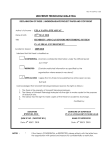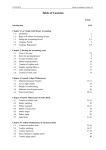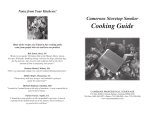Download Listening in Daily Life
Transcript
2 Listening in Daily Life TOPIC OVERVIEW 2.1 2.2 2.3 2.4 Listening for Directions Listening in Casual Conversation Anticipation and Inference Skills In Listening Listening for Gist and Important Ideas in the Media Summary In our daily lives we do a lot of listening. We listen not only to mainly communicate, but to also fulfil many different purposes. Everyday listening also involves listening to features of informal language being used. In everyday conversation, for instance, speakers often use short and brief sentences. Other spoken factors such as tone of voice and intonation also come into play. 24 LEARNING OUTCOMES By the end of this chapter, you should be able to: 1 2 3 4 carry out some common directions you listen to; listen for main ideas and specific details in a conversation; infer and anticipate ideas in a listening task; and determine the gist and important ideas in listening material from the media. 25 2.1 LISTENING FOR DIRECTIONS Have you ever been to a place for the first time and you do not know your way. When you ask for directions, you need to listen carefully to what the person directing you is saying. Or have you tried listening for directions on how to do something, for instance, baking a cake or setting up your new computer? Activity 2.1 Welcome to Central town. This guide helps you to find your way around town. You will soon discover that much of what you need, can be found in Central. For exact locations of specific places and buildings, please use the map given to you. Let’s explore the town with the help of the map. There are four main roads in Central town other than the smaller streets. They are West street, East street, North street and South street. Many of the bigger shops and stores, restaurants, public utilities and offices are found along these main roads. You can find a bar, a bank, a hotel, the City Hall, a bookstore and a steak house on West street. There’s a bowling alley on North street. You can also find a public library and a post office on South street. If you wish to visit the local zoo, there’s one on East street. In addition, if you go along East street, you will soon come across a police station, a bus station and a public school. There is also a supermarket and a hospital opposite to these buildings on the same road. For further details on these places, kindly refer to the brochures provided. We hope you will have a pleasant stay in friendly Central town. Please board Central town. 26 ACTIVITY What are some of the factors which could help us become good listeners?. Look at the map and listen to the CD script Activity 2.1. Write T (True) or F (False) next to each statement in the following exercise. Activity 2.2 You are making cookies for the first time. Listen to the instructions on how to make Chocolate Chip Cookies. Then complete the following exercise. Instructions: You will need the following ingredients: ¾ cup firmly packed brown sugar ½ cup sugar ½ cup margarine or butter (soften) ½ cup shortening 1½ tea spoons vanilla 1 egg 1¾ cups all-purpose-flour 1 tea spoon baking soda ½ tea spoon salt 6-ounce-packaged or one cup of semi sweet chocolate chips ½ cup chopped nuts or shelled sunflower seeds; if desired Procedure: Step 1 Step 2 Step 3 Step 4 Step 5 Step 6 Step 7 Step 8 Preheat oven to 375OF. In a large bowl, beat brown sugar, sugar, margarine and the shortening until light and fluffy. Add vanilla and egg. Blend well. Lightly spoon flour into measuring cup. Level off. Stir in flour, baking soda and salt. Mix well. Stir in chocolate chips and nuts. Drop by tea spoon full, two inches apart, onto ungreased cookie sheet. Bake at 375OF for 8 to 10 minutes or until light golden brown. 27 Step 9 Step 10 Cool for 1 minute. Remove from cookie sheet. Make 4 dozen cookies. Based on the CD script to which you have listened, circle the correct answer: 1. Which of the following is not an ingredient in the recipe? A. Brown sugar B. Oat bran C. Butter D. Baking soda 2. At what temperature should the oven be set? A. 357 Degrees Fahrenheit B. 375 Degrees Fahrenheit C. 400 Degrees Fahrenheit D. 450 Degrees Fahrenheit 3. When do you add in the vanilla and egg? A. After stirring in the flour, salt and baking soda. B. After adding in the chocolate chips and chopped nuts. C. Once the sugar, margarine, and shortening are light and fluffy. D. Once all ingredients have been mixed well. 4. Which of the following statements is true? A. Do not grease the cookie sheets. B. Bake the cookies for half an hour. C. Remove cookies immediately from baking sheet. D. The recipe makes 30 pieces of cookies. 5. How do you place the dough onto the baking sheet? A. Shape the soft dough with your fingers and place onto the baking sheet. B. Use a teaspoon to scoop the dough onto the baking sheet. C. Drop the dough onto the baking sheet using a fork. D. Lightly spoon dough onto baking sheet with a dessert spoon. Activity 2.3 You have just bought a mobile phone. You need to install the SIM card. The phone is equipped with a user’s manual. Listen to the CD script Activity 2.3 which contains directions guiding you on how to install the SIM card. Then, complete the following task. Fill in the blanks with the correct words you hear from the directions. Inserting A SIM Card Safety reminders: 1. Keep all miniature SIM cards out of small children’s reach. 28 2. The SIM card and its contacts can be easily damaged by scratches or bending. Be careful when handling, inserting or removing the card. 3. Before installing the SIM card, always make sure that the phone is switched off and then, remove the battery. How to inset your SIM card: Step 1 Step 2 Step 3 Press the locking catch. Slide the cover open and lift the cover. Push the two catches in the opposite directions and lift the battery. Slide the SIM card carefully into the SIM card slot. Make sure that the golden connectors on the card are facing downwards and that the level corner is on the left. Align the golden connectors on the battery with the corresponding connectors on the phone and push the opposite ends of the battery until it snaps into place. Insert the two catches of the back cover in the corresponding slot in the phone and slide the cover towards the bottom of the phone until it locks into place. Step 4 Step 5 golden connectors slots battery children’s damaged opposite locks left downwards locking catch catches switched off connectors Activity 2.4 You can check your answers from the following word list: Instructions: (a) (b) (c) Listen to the CD script Activity 2.4. Solve the puzzle by following the directions. Rearrange the following steps based on what you have listened to in the directions. Fold your arms. One hand should be under the other arm. Your arms should be hugging your body. With arms still folded, pick up the string at both ends. Unfold your arms without releasing both ends of the string. As you do so, the knot will be naturally tied. Activity 2.5 Instructions: (a) Listen to the CD script Activity 2.5. (b) Answer the following questions. 29 • CD script 2.5a (Voicemail Message on a Mobile Phone) 1. 2. 3. 4. • CD script 2.5b (Answering Machine Message) 1. 2. 3. 4. 5. 6. 7. 8. 9. • Who is the caller? Which company does she work with? Why did she call? What has Encik Ahmad won? What’s the number he has to quote to claim the gift? Where is the shop? Does the shop open everyday? What is the deadline for picking up the gift? What is the caller’s mobile phone number? CD script 2.5c (Radio Announcement) 1. 2. 3. 4. 5. 6. 7. 8. • What’s the caller’s name? What does he want Ann to do? Where did he leave the wallet? Why does he want Ann to give it to his friend? What is the announcement about? Who is organising the event? When will the event be held? Where will the event be held? What’s the main attraction of the event? Who can be contacted for details? What is the contact number? Is entrance free? CD script 2.5d (Applying the Heimlich Manoeuvre) Listen to the CD script on the first aid method for dealing with a person who is choking on food called the Heimlich Manoeuvre. (Your instructor will briefly explain the origin of the first aid method). Then, put the steps in the right order based on what you have heard. [Adapted from: Blanchard, K. and Root, C. (1982). Ready to Write. p.43. New York: Longman.] (Note: This manoeuvre should be conducted only in emergency cases where no one available is able to provide first aid.) 30 2.2 LISTENING IN CASUAL CONVERSTION Our day-to-day events are filled with situations whereby we need to listen attentively to communicate successfully with people around us. Conversing with others require that we pay attention and are aware of the various cues accompanying spoken language. Daily conversations using the English language often use informal speech which has unique features such as the use of incomplete utterances, repetitions, hesitations, etc. In addition, being alert to other factors such as tone of voice, intonation, rhythm, and background noise will help you determine the meaning of such speech. Activity 2.6 This section provides you with activities which can help you practise your listening skills in conversations. Greetings and Introductions (a) (b) Listen to the CD script Activity 2.6. Fill in the table with the relevant information based on what you hear. Activity 2.7 On the Telephone (a) (b) (c) Listen to the CD script Activity 2.7. Answer the following questions for each conversation. Practise with your friend the conversations using your own information. • CD script 2.7.1 1. 2. 3. 4. • What is the caller’s name? Who does s/he want to speak to? What is the name of the company? Do you think the caller spoke to the person he was calling? CD script 2.7.2 1. 2. Who did you call? What happened? 31 • CD script 2.7.3 1. 2. 3. • What place did the caller call? Whom does s/he wish to speak to? What happened? CD script 2.7.4 1. 2. 3. Who did you call? Why did you call? What did Dr Doolittle say? Activity 2.8 Asking for Favours (a) (b) (c) Listen to CD script Activity 2.8. Fill in the blanks for each conversation. Practise the conversations with your friend using your own information. • CD script 2.8.1 I ask you for a favour? Of course. you be able to return this book to the library for me, please? It’s. Sure. I’m going there this . Thanks a lot. You’re . It’s no trouble. • CD script 2.8.2 Have you got a Yes. A B A B Siti Siti Lilian Siti Lilian ? : A : B : : : : Can I it? Certainly. I’ll it to you. And I use your calculator for a few minutes, please? Sure. . • CD script 2.8.3 : : : : : Are you going ? Lilian : Yes, I am. Can I with you? . Where do you want to go? To Jalan Gasing. All right. • CD script 2.8.4 Neighbor A : Oh hello, Puan Saodah. 32 : : : : : : Sheila Pramita Sheila Pramita Sheila Pramita Could I use your telephone ? My phone’s not working. Neighbor B : All right. Neighbor A : And is that this morning’s ? Neighbor B : Yes, it is. Neighbor A : I borrow it? Neighbor B : Sorry, I haven’t finished reading it yet. Neighbor A : Oh, . It doesn’t matter then. 33 ANTICIPATION AND INFERENCE SKILLS IN LISTENING 2.3 An important sub-skill of listening is to be able to guess and figure out ahead of time what is to be said by the speaker. In addition, effective listening requires the ability to listen amid the noise around us. Sometimes, we can anticipate words or phrases that naturally come after those that we have heard in a message. How often do you experience the feeling that you know what exactly the speaker will say next in a conversation? In this section, you will practice anticipation and inference skills useful for a number of common listening situations. Activity 2.9 Instructions: For tasks 1 and 2, do the following: (a) Listen to the CD scripts. (b) Guess what the object or product is. (c) Check your answers with your tutor. Task 1 (CD script 2.9.1) 34 Task 2 (CD script 2.9.2) Fill in the blanks with the appropriate statement, question, or response. Choose from the answers given. • A Telephone Exchange Can I speak to Lily, please? I’m sorry. She’s not in. : Tina : Voice : Tina . (Can you tell her I called? / Can I leave a message?) Yes, what will that be? And can I have your name, please. I’m Tina. Please tell her I will meet her at 4 this evening. All Right. Thank you. . (Not at all / Thank you / Goodbye) : : : : : 35 Voice Tina Voice Tina Voice • At an Interview Good morning! Please have a seat. . (Thanks / Thank you / That’s very nice of you) How shall I address you? . (Call me Mat / No.23, Jln Lengkong, Kajang, Selangor/ My name is Ahmad) Where did you study for your degree in marketing? . (At a private university in England / At University of Reading / At a College near my house) Mmm… Are you still working at P & Q Advertising? . (Yes, I am. But I want to leave / Yes / No) Why is that? Ahmad Encik Zul : : Encik Zul : Ahmad : Encik Zul : Ahmad : Encik Zul : Ahmad : Encik Zul : Ahmad : Encik Zul Well, the company isn’t doing very well. There are a lot of problems. : . (Oh.. really? What are the problems? / Mmm…tell me about it / Can you explain that?) Task 3 (CD script 2.9.3) Dictation: (a) (b) Listen to an English song. Write down the lyrics of the song. (c) What is the song about? (d) What are some words in the song that you do not understand. (e) Share the information with your friends. (f) Write a short essay about the song and read it to your friends. NB : Your instructor will play a song for you to listen. A transcript of the song (with some deleted words) will be given to you. You need to fill in the blanks with the correct word (words you hear in the song). 36 2.4 LISTENING FOR GIST AND IMPORTANT IDEAS IN THE MEDIA Listening to the news, announcements, excerpts of events on the radio and television requires the skill of listening for the main points or ideas. You need to listen with accuracy and understanding. It also demands the listener’s interpretation of what is heard. This section exposes you to some common activities which provide you with practice in listening for gist of ideas and important details. Activity 2.10 Instructions: (a) Listen to the CD script Activity 2.10 on news highlights (CD script 2.10.1 to 2.10.7). (b) Match the headlines below with the news highlights. (c) State the main idea of each news highlight. Activity 2.11 Instructions: (a) Listen to the CD script Activity 2.11 on an interview on the radio about a British ski- jumper talking about his experience. (b) Read the three summaries given to you. (c) Decide which of the summaries is correct. Activity 2.12 Instructions: (a) (b) Listen to the CD script Activity 2.12 on the movies showing at cinemas in the city. Answer the following questions: 1. 2. 3. 4. You want to watch the movie “Hero”. Where should you go to? Your friend wants to watch the movie “Shanghai Knights”. Does he have a choice of cinemas? Are there any movies in Bahasa Melayu? Where is it showing? What number should you call to make a reservation? 37 5. 6. How many Hindi movies are showing and where can one go to watch it? If you need details about the movies and the times of the shows from the Internet, where can you go to? SUMMARY In this chapter, our discussion focuses on everyday listening activity. We started the chapter by focusing on listening for directions. Then, we were introduced to listening for casual conversation. We also discussed the skills to guess and figure out what is to be said by the speaker. Finally, we were exposed to skills to listen with accuracy and understanding, which help us to interpret what is being heard. 38




















